Step into Thai cuisine's fragrant, flavorful world with our Thai Shrimp Green Curry Recipe. This exquisite dish is a symphony of fresh herbs, spices, and succulent shrimp, all harmonizing beautifully in a creamy coconut milk base. Whether you're a novice or a seasoned cook, our detailed guide will lead you through creating this authentic, mouthwatering curry that will captivate your taste buds and elevate your dinner table. Let's dive into this culinary journey and bring a piece of Thailand into your home kitchen.
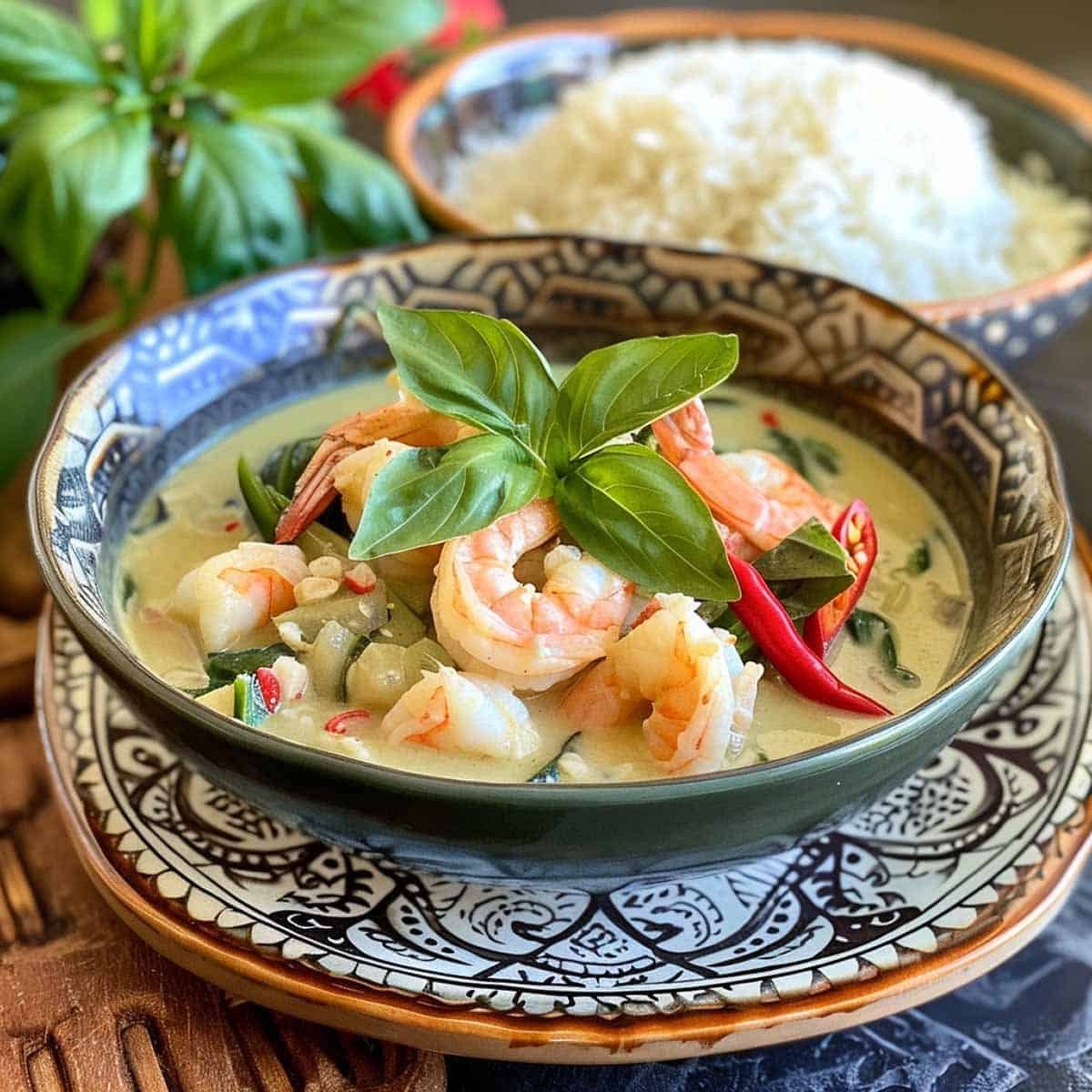
Background and Influence of Thai Shrimp Green Curry
Thai Shrimp Green Curry, or "Gaeng Kiew Wan Goong" in Thai, is steeped in centuries-old culinary traditions. Additionally, its vibrant green color and intricate flavors stem from a blend of native herbs and spices. Moreover, the curry paste, traditionally prepared with a mortar and pestle, is a unique method that extracts essential oils from ingredients like green chilies, kaffir lime leaves, and galangal. This method embodies Thailand's dedication to authentic flavors and craftsmanship.
Thai Shrimp Green Curry, a dish that embodies the essence of Thai cuisine, has not only garnered global acclaim but also enriched international culinary scenes. Whether savored in Bangkok or enjoyed worldwide, it continues to captivate diverse palates, showcasing Thailand's culinary prowess and its enduring influence on global gastronomy. This enduring influence is a testament to the rich cultural exchange in the culinary world, inspiring chefs and food enthusiasts alike.

Sawasdee Kha, and Hello
I'm thrilled to share my Thai Shrimp Green Curry, a dish that not only tantalizes the taste buds but also brings back a flood of nostalgic memories. It's about the joy of cooking for my children as they grew up. Thai Shrimp Green Curry became a cherished tradition in our family, uniting us around the dinner table.
The lingering aroma of green chilies and fresh herbs that filled our kitchen, creating an ambiance of warmth and joy, is a memory I hold dear. Each time we savored this creamy curry with succulent shrimp, it was a moment of pure comfort, brimming with laughter and shared stories.
As my children have grown and moved on to create their own homes, Thai Shrimp Green Curry remains a dish that connects us. We revisit this recipe often to relive cherished memories and create new ones.
I encourage you to try this recipe and bask in the joy it brings to your family gatherings. Share your experiences with us in the comments below. How did it turn out for you? Did it bring back memories of your own kitchen adventures? I'm eager to hear from you and share in our collective love for good food and cherished memories.

Welcome! I'm excited you're here. Let's cook Thai Shrimp Green Curry Recipe Together—it'll be amazing!
Essential Elements for Making Thai Shrimp Green Curry Recipe
The magic of Thai Shrimp Green Curry lies in its fresh and flavorful ingredients. Moreover, you'll need succulent shrimp, rich coconut milk, and a variety of fresh vegetables like bell peppers and eggplant. Additionally, the star of the dish, green curry paste, is a fragrant blend of green chilies, garlic, ginger, and other spices that provide its signature taste. Furthermore, fresh Thai basil and lime juice add a refreshing finish. Refer to the recipe card for exact quantities and ensure everything is ready for a seamless cooking experience.
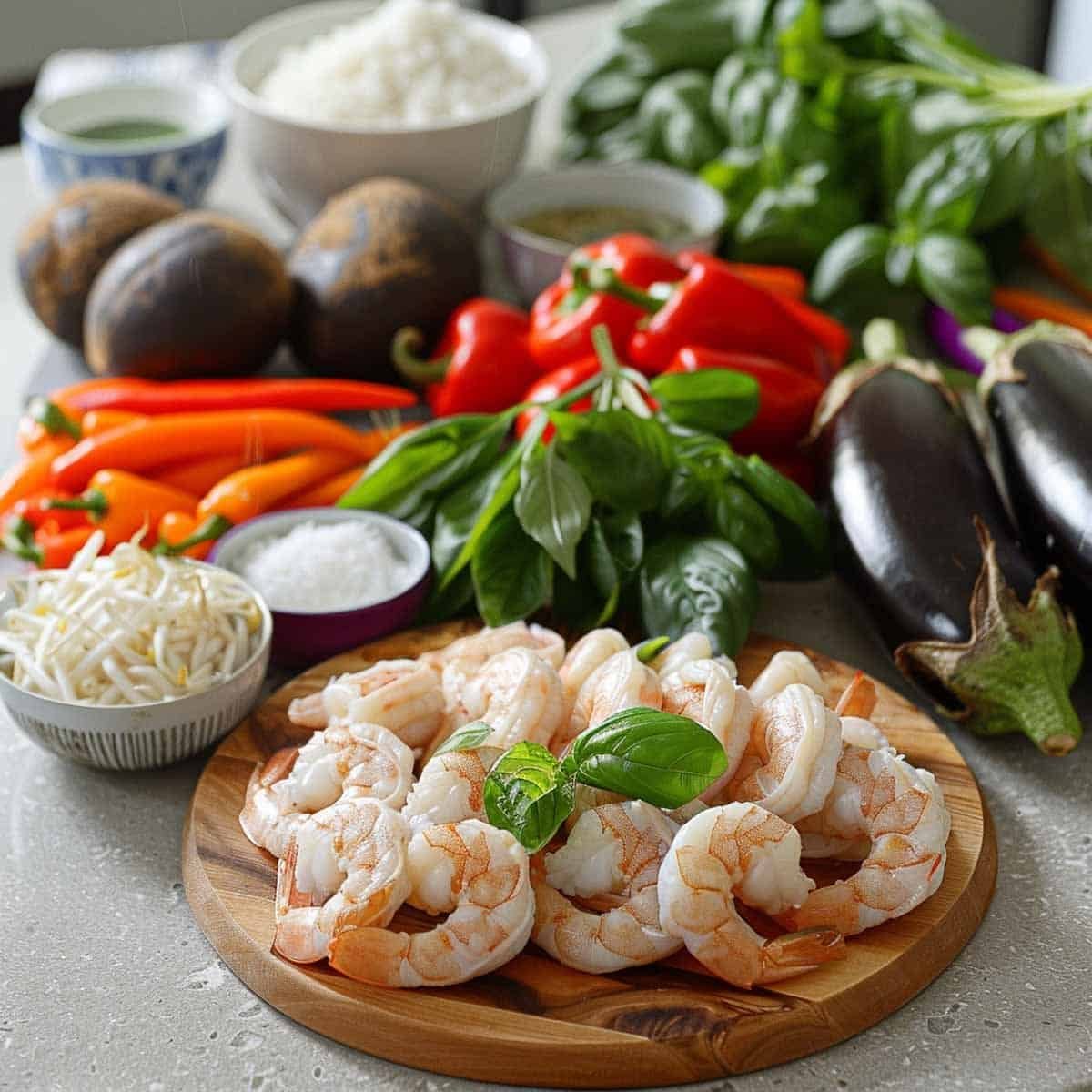
Prepare the Ingredients
Gather all your ingredients, ensuring the shrimp are peeled and deveined, vegetables are chopped, and aromatics like garlic and ginger are minced. Additionally, this preparation step is crucial for a smooth cooking process, allowing you to focus on cooking without interruptions.
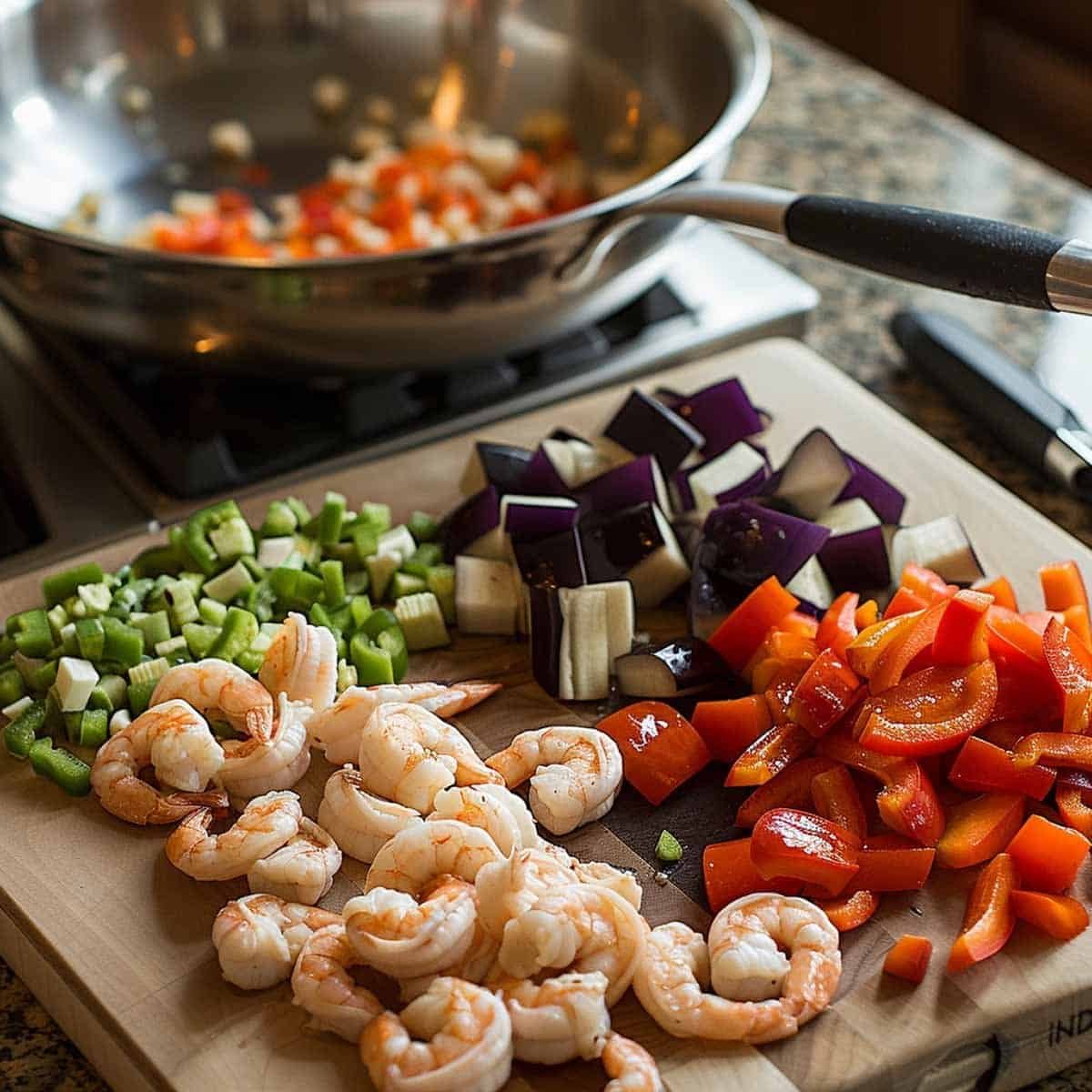
Sautéing Aromatics
Heat vegetable oil in a large pan over medium heat. Then, add minced garlic, ginger, and green curry paste.Sauté for 2-3 minutes until fragrant. This step releases essential oils from the spices, enhancing the curry's flavor profile.
Add liquids and veggies
Then pour in coconut milk and chicken broth, stirring to combine. Add fish sauce and brown sugar, then bring to a simmer. next add bell peppers, eggplant, and bamboo shoots. Cook for 5-7 minutes until vegetables are tender but still vibrant, infusing the curry with their flavors.
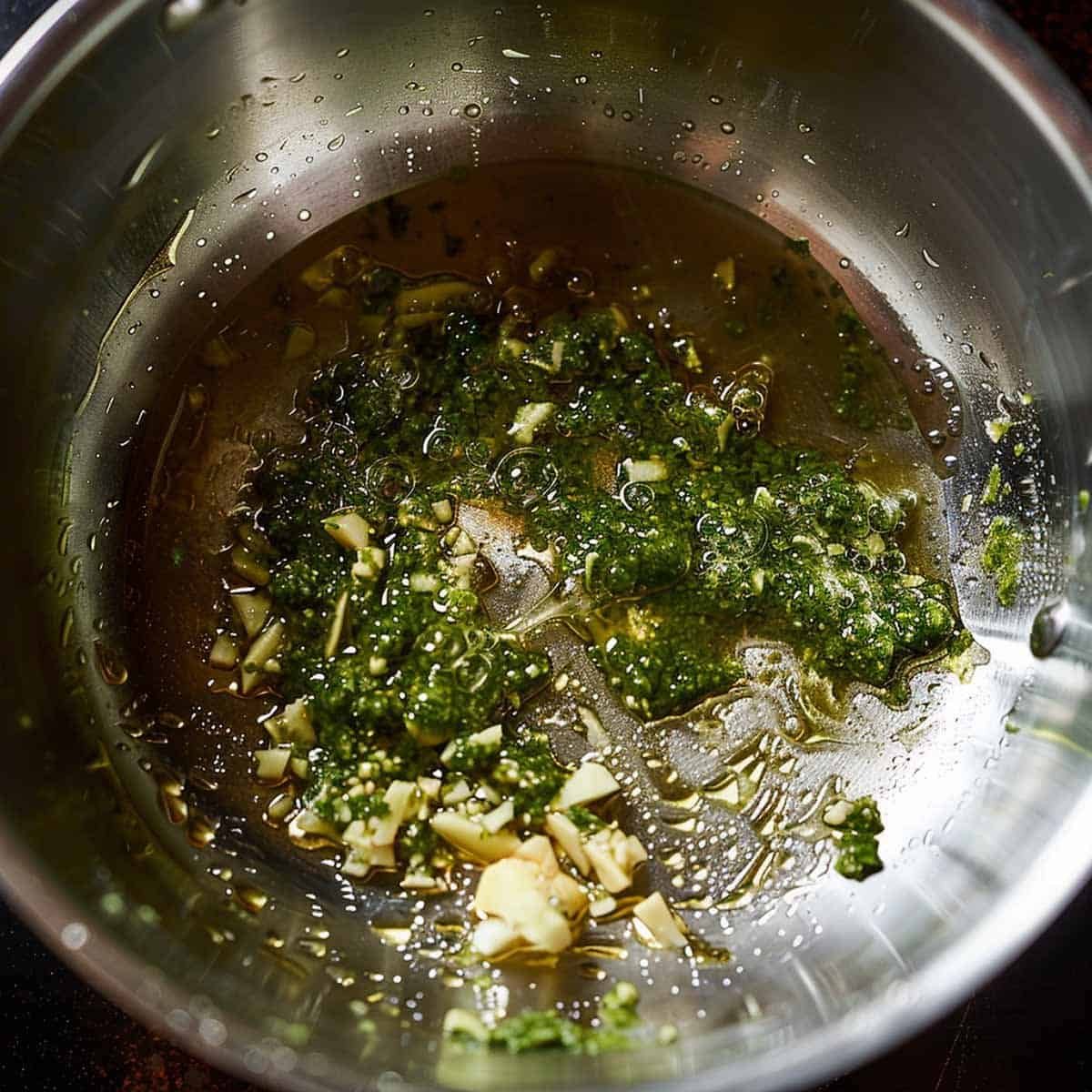
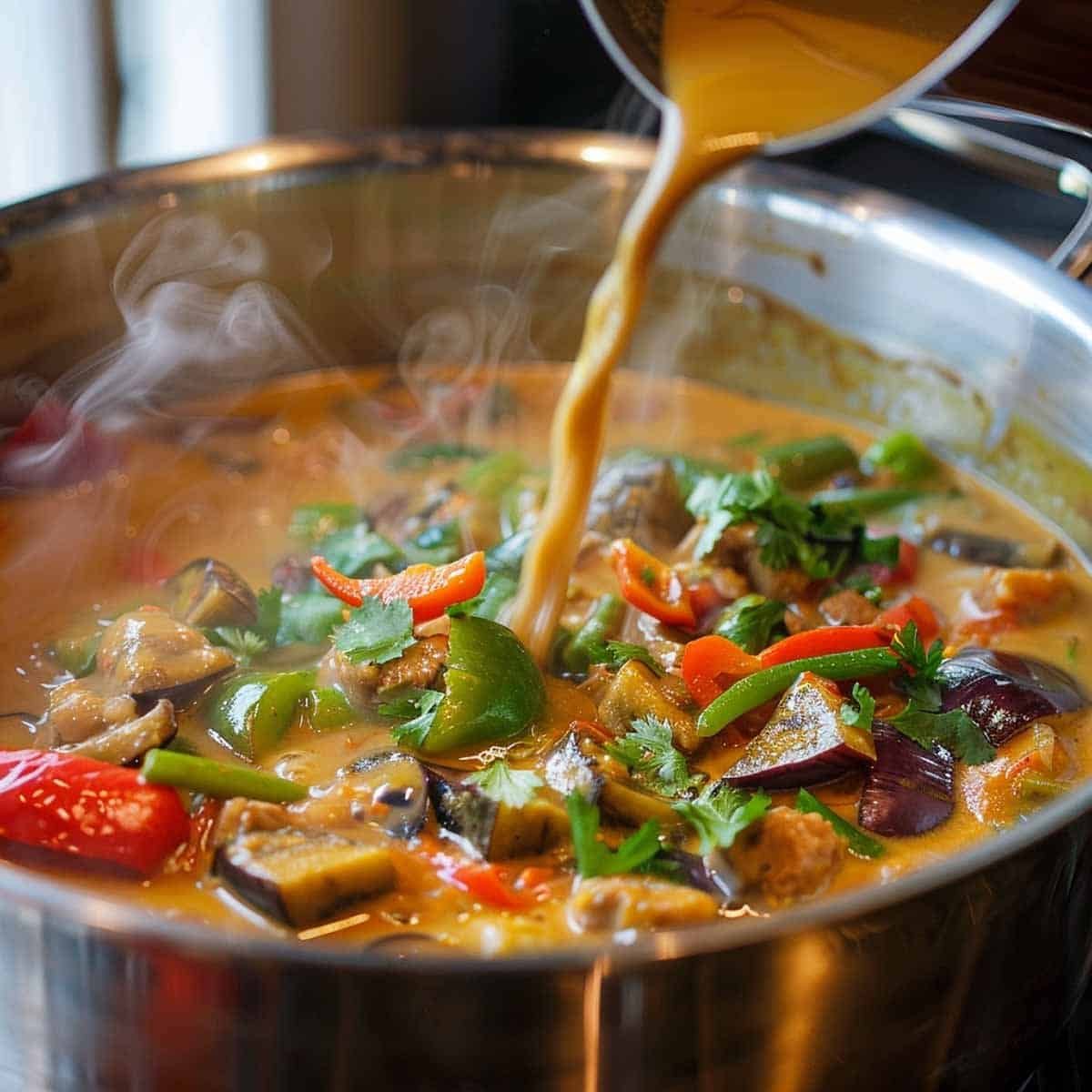
Cooking the shrimp
Add shrimp to the pan and cook for 3-4 minutes until pink and opaque. Then Stir in lime juice and Thai basil leaves, allowing the basil to wilt slightly. begin to adjust seasoning with fish sauce or sugar if needed.
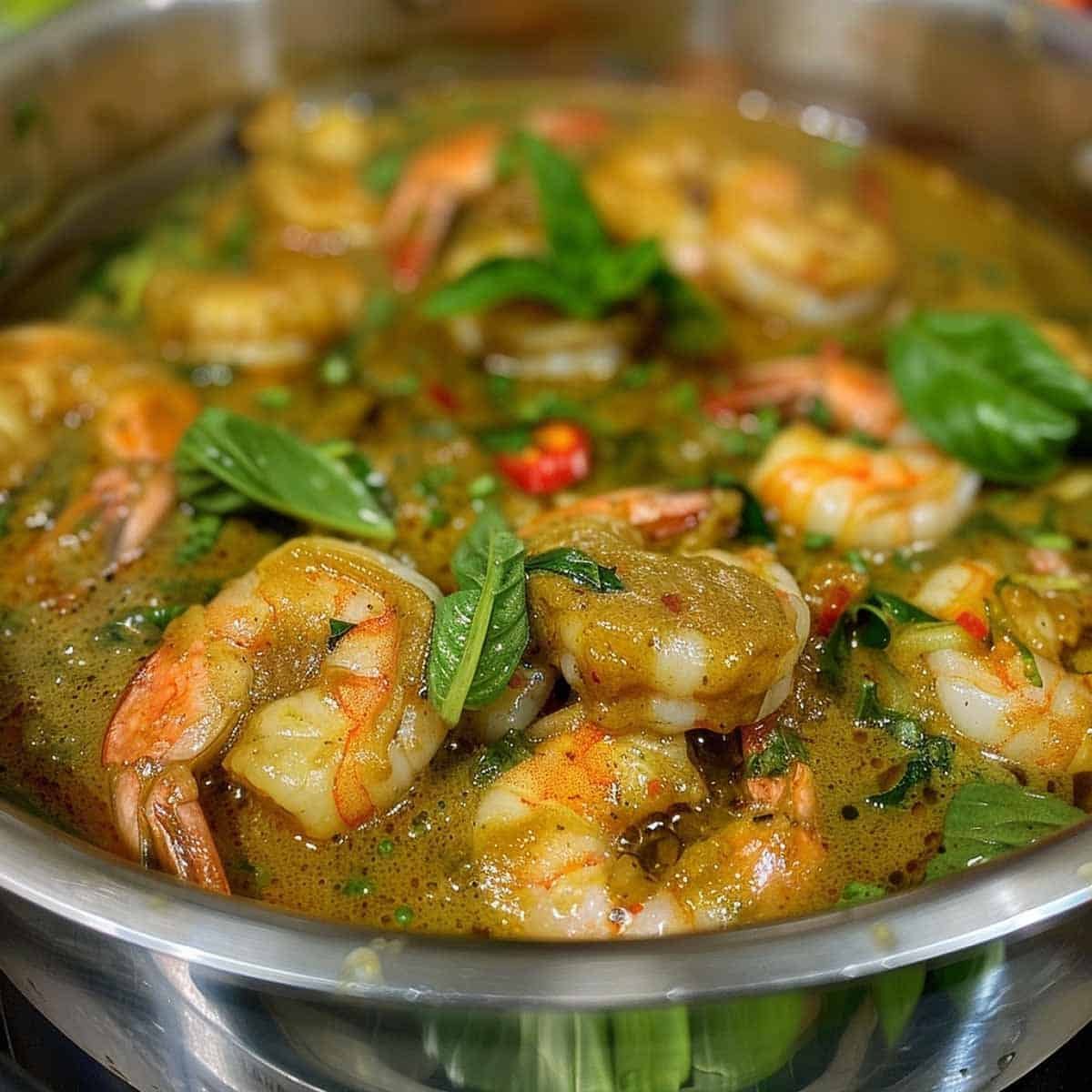
Serving the Curry
Serve hot, garnished with fresh Thai basil and sliced red chili. Pair with steamed jasmine rice to soak up the delicious sauce. Enjoy the rich, complex flavors of this traditional Thai dish.
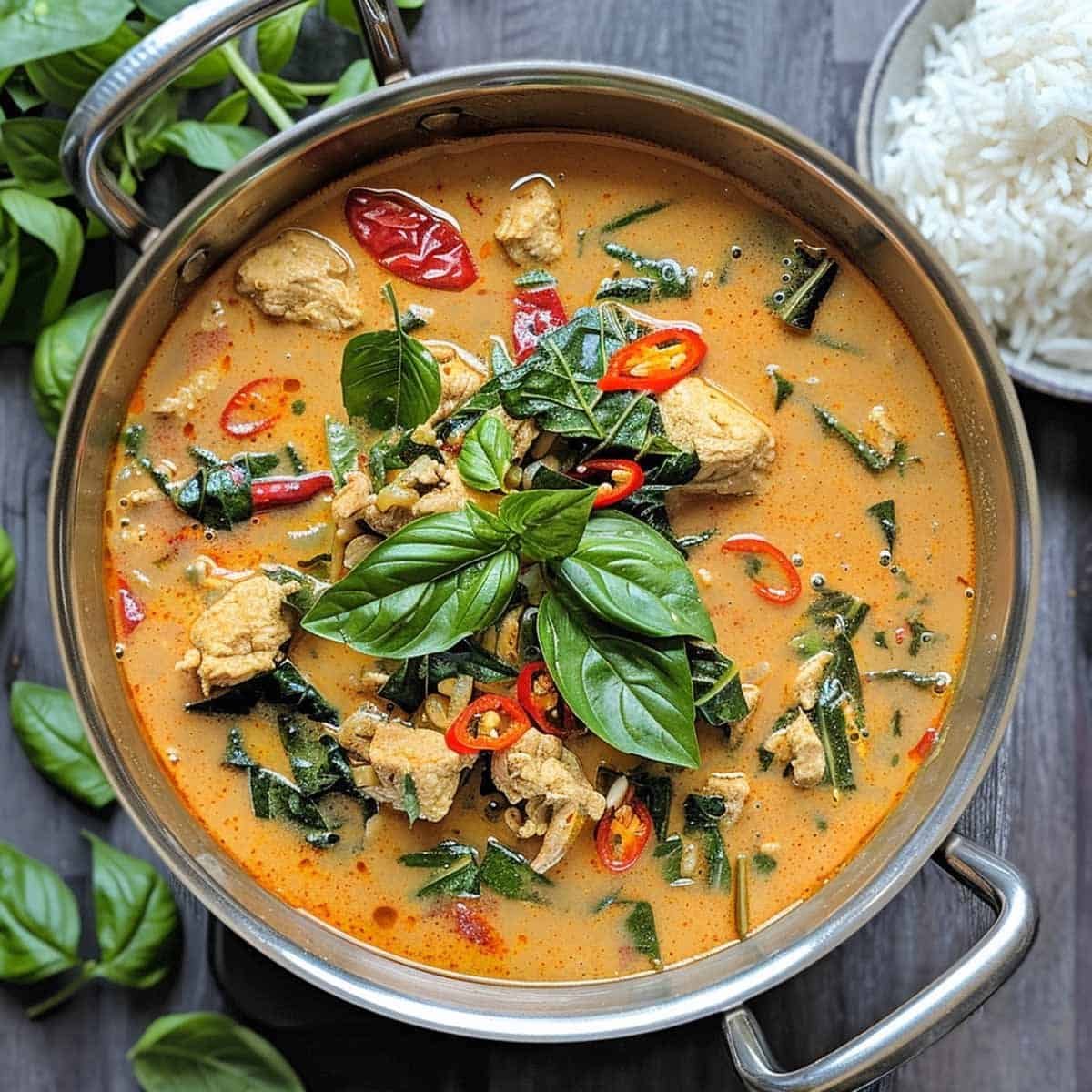
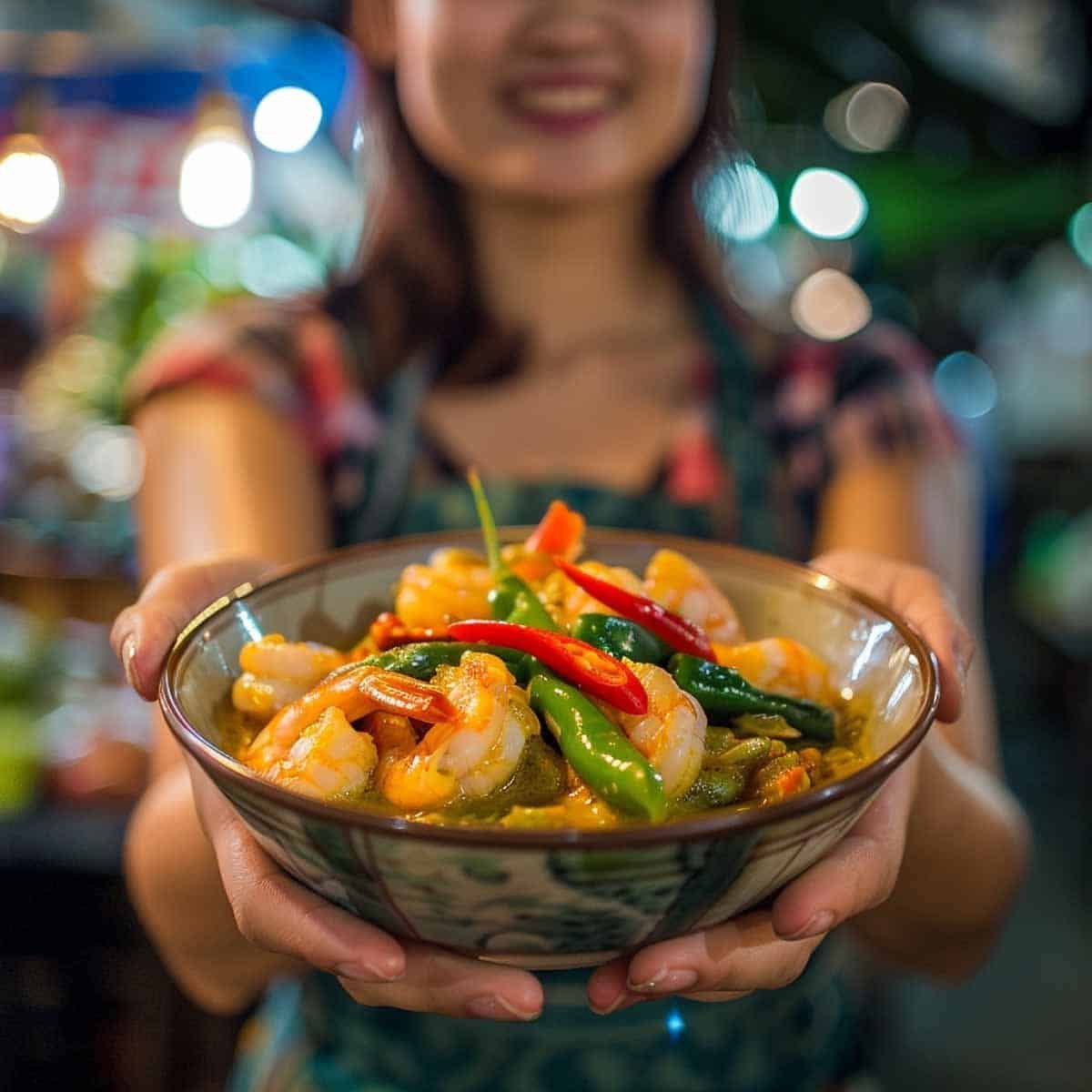
Tasting Notes For This Thai Shrimp Green Curry Recipe.
Visual: Thai Shrimp Green Curry dazzles with its vibrant green hue, thanks to a blend of fresh green chilies, basil leaves, and kaffir lime. Shrimp add pops of pinkish-white, creating an inviting contrast. Its creamy texture from coconut milk gives it a luxurious appearance, urging you to indulge.
Aroma: As you approach, the aroma is irresistible with pungent green chilies, citrusy kaffir lime, and hints of lemongrass and galangal. Simmering coconut milk adds a sweet, nutty scent, promising a comforting and flavorful experience.
Taste: Thai Shrimp Green Curry offers a harmonious blend of flavors. Moreover, creamy coconut milk envelops tender shrimp and vegetables, complemented by layers of spicy, salty, and subtly sweet notes from the curry paste. This balance ensures that the sweetness of coconut milk perfectly offsets the spiciness of green chilies, creating a nuanced and comforting taste profile.
Texture: The curry's texture is delightful, with a smooth, velvety mouthfeel from coconut milk. Tender shrimp offer a meaty bite, while bell peppers and bamboo shoots add crunch softened by the curry's simmering. Each spoonful is a textural symphony that engages all senses, making dining memorable.
Heat: The moderate spiciness of Thai Shrimp Green Curry varies with the amount of green chili, which is tempered by coconut milk's sweetness. Furthermore, its gentle heat adds pleasant warmth without overwhelming, allowing you to savor the curry's complexity and enjoy its nuanced flavors.
For a complete experience, pair it with steamed jasmine rice to balance spice and richness. These notes capture Thai Shrimp Green Curry's sensory journey—visual allure, aromatic promise, balanced taste, delightful texture, and nuanced heat—ensuring its place as a beloved Thai dish.
Thai Shrimp Green Curry : Pairing, Serving, and Storage Tips.
Pairing Suggestions and Side Dishes
Pad Thai: The sweet and tangy flavors of Pad Thai balance the spiciness of the curry, creating a harmonious contrast of textures and flavors. Additionally, the combination offers a delightful sensory experience.
Thai Mango Salad (Som Tum): The crisp and refreshing flavors of Thai Mango Salad contrast the creamy curry, while the sweetness of mango complements the curry's spiciness.
Thai Spring Rolls: Crispy and light Thai Spring Rolls provide a textural contrast to the creamy curry, while the fresh vegetables and herbs inside offer a refreshing bite that complements the rich flavors of the curry.
Chicken Satay: The smoky and savory flavors of Chicken Satay, coupled with the nutty richness of the peanut sauce, create a luxurious indulgence that complements the creamy curry.
Sticky Rice: The neutral and slightly sweet flavor of Sticky Rice, along with its sticky texture, provides a satisfying contrast to the spiciness of the curry, leaving you feeling content after each bite.
Together, these dishes create a balanced Thai meal with a variety of flavors and textures that complement each other well, making each bite a delightful experience.
How to Serve
Serve Thai Shrimp Green Curry in a large bowl, garnished with fresh Thai basil and sliced red chili. Then place a serving of steamed jasmine rice on the side to soak up the flavorful sauce. Present the curry and rice in separate dishes for a communal meal, allowing guests to serve themselves. This approach not only showcases the vibrant colors and textures of the curry but also creates a welcoming, shared dining experience.
Reheating Options
To reheat Thai Shrimp Green Curry, transfer it to a saucepan and warm over medium heat, stirring occasionally until heated through. Alternatively, microwave individual portions in a microwave-safe dish, covering loosely with a lid or microwave-safe wrap to prevent splatters. Heat in 1-minute increments, stirring in between, until hot. Avoid overheating to maintain the shrimp's tender texture.
Make-Ahead and Storage
Make the curry ahead by preparing it up to the point of adding the shrimp. Additionally, store the curry base in an airtight container in the refrigerator for up to 3 days. When ready to serve, reheat the base and cook the shrimp before serving. This method ensures the shrimp remains fresh and tender. Moreover, store leftovers in the refrigerator for up to 2 days, reheating as needed. Visit foodsafety.gov for more information.
Required Kitchen Equipment for Thai Shrimp Green Curry
- Large Pan: Essential for cooking the curry and ensuring even heat distribution.
- Knife and Cutting Board: Used for chopping and preparing all ingredients efficiently.
- Measuring Cups and Spoons: Ensure precise measurements for all ingredients.
- Stirring Spoon: Necessary for mixing the curry and incorporating all flavors.
Tips for Authenticity and Customization For Thai Shrimp Green Curry Recipe
Using Authentic Ingredients
For an authentic Thai Shrimp Green Curry, using traditional ingredients is key. Opt for fresh Thai basil over sweet basil, imparting a unique, aromatic flavor. Similarly, use genuine green curry paste, which contains authentic Thai spices like galangal and kaffir lime. Freshly squeezed lime juice and high-quality coconut milk ensure the curry's richness and balance. These ingredients enhance the dish's authenticity and elevate its overall taste, making it a true representation of Thai cuisine.
Adjusting Spiciness and Flavors
Start with the green curry paste to adjust the spiciness and flavors of your Thai Shrimp Green Curry. Additionally, for a milder curry, use less paste and consider removing the seeds from the chilies. Conversely, add more paste or extra sliced red chilies for a spicier kick. Balancing flavors is equally essential; add more fish sauce for saltiness, lime juice for acidity, or brown sugar for sweetness. Taste as you go, adjusting gradually to suit your preference. This flexibility allows you to customize the curry to your desired heat level and flavor profile.
Substitutions
Several substitutions can be made for this Thai shrimp green curry for dietary needs. Additionally, for a vegetarian version, substitute shrimp with tofu or a mix of vegetables like zucchini and mushrooms. Use tamari or coconut aminos instead of fish sauce for a gluten-free option. If you prefer a lighter dish, opt for light coconut milk. Moreover, chicken or chickpeas can be excellent protein alternatives for those with seafood allergies These substitutions ensure the dish remains flavorful while accommodating different dietary requirements.
Alternative Garnishes
Enhance your Thai Shrimp Green Curry with various alternative garnishes. Fresh cilantro adds a burst of herbal freshness, while finely sliced green onions provide a subtle crunch. Toasted sesame seeds can add a nutty flavor, and a drizzle of coconut cream can make the dish richer. Furthermore, serving with a few lime wedges on the side enhances the dish with a citrusy brightness. These garnishes elevate the dish's visual appeal and introduce complementary flavors and textures.
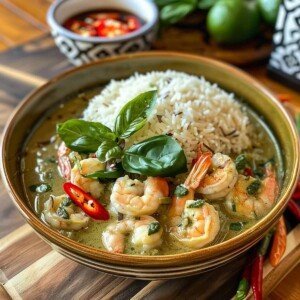
Authentic Thai Shrimp Green Curry Recipe
Ingredients
- 1 lb shrimp peeled and deveined
- 2 tablespoon green curry paste
- 1 can 14 oz coconut milk
- 1 cup chicken broth
- 2 tablespoon fish sauce
- 1 tablespoon brown sugar
- 1 cup bamboo shoots drained
- 1 cup bell peppers sliced
- 1 cup eggplant cubed
- ½ cup Thai basil leaves
- 2 tablespoon vegetable oil
- 1 lime juiced
- 1 tablespoon ginger minced
- 3 cloves garlic minced
- 1 red chili sliced (optional)
- Steamed jasmine rice for serving
Instructions
- Preparing the Ingredients: Start by prepping all your ingredients. Peel and devein the shrimp, slice the bell peppers, and cube the eggplant. Mince the garlic and ginger and cut the red chili. Having everything ready before cooking not only makes the process smoother but also adds to the enjoyment of cooking.
- Sautéing Aromatics: In a large pan, heat the vegetable oil over medium heat. Add the minced garlic, ginger, and green curry paste. Sauté for 2-3 minutes until the mixture is fragrant and the curry paste has dissolved into the oil. This step is crucial as it releases the essential oils in the spices, intensifying the flavors of your curry.
- Add liquids and veggies: Pour in the coconut milk and chicken broth, stirring well to combine. Add the fish sauce and brown sugar, then bring the mixture to a simmer. Add the bell peppers, eggplant, and bamboo shoots, and let the vegetables cook for 5-7 minutes until they are tender but still vibrant.
- Cooking the Shrimp: Add the shrimp to the pan and cook for 3-4 minutes until they turn pink and opaque. Stir in the lime juice and Thai basil leaves, allowing the basil to wilt slightly. This is the time to taste and adjust the seasoning with more fish sauce or sugar if needed, ensuring your curry is perfectly balanced.
- Serve the curry: Now, it's time to enjoy the fruits of your laborServe the Thai shrimp green curry hot, garnished with fresh Thai basil leaves and sliced red chili for an extra kick. Pair it with steamed jasmine rice to soak up the delicious sauce. Revel in the rich, complex flavors of this traditional Thai dish in the comfort of your home.
Nutrition
Frequently Asked Questions for Thai Shrimp Green Curry
Absolutely! You can easily substitute the shrimp with tofu or an array of vegetables such as zucchini and mushrooms. These alternatives absorb the curry's flavors wonderfully, providing a satisfying and delicious vegetarian option.
The spiciness of this curry is highly adjustable. Additionally, you can control the heat level by varying the amount of green curry paste and fresh chilies you use. For a milder curry, use less paste and fewer chilies, or for a spicier kick, add more according to your taste preference.
Yes, you can freeze the curry base, but for the best results, adding fresh shrimp when reheating is recommended. This ensures the shrimp maintain their ideal texture and flavor, providing a more enjoyable dining experience. Additionally, it helps preserve the delicate balance of flavors in the dish.
Tamari or coconut aminos are excellent gluten-free alternatives to fish sauce. They offer a similar umami flavor, making them perfect substitutes while accommodating dietary restrictions.


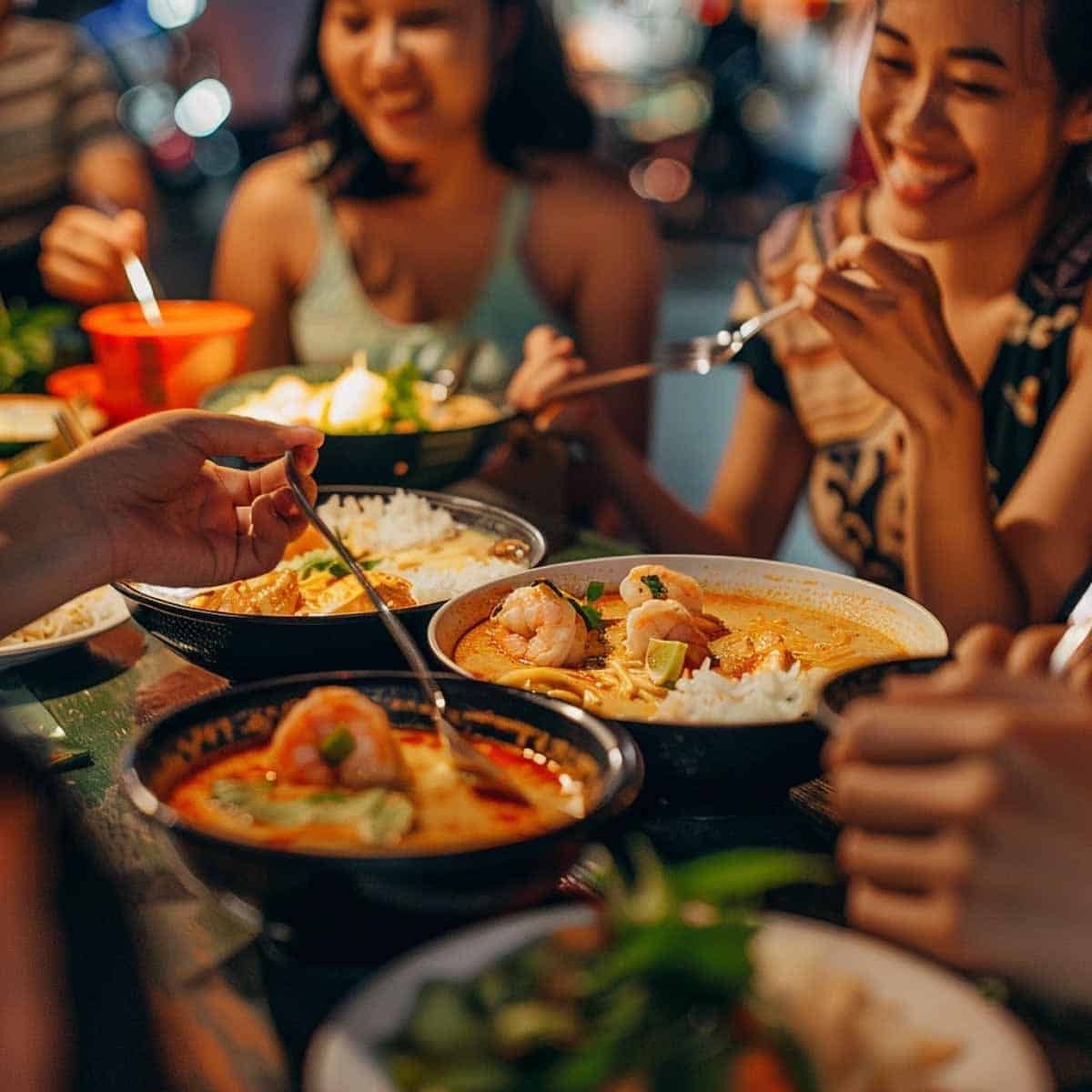


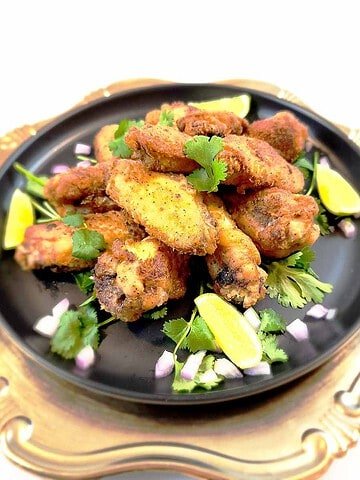

Leave a Reply